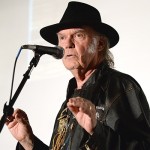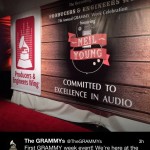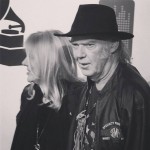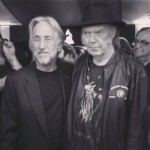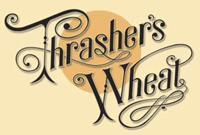Written by Shar on 26 January 2014
 An insightful blog posting by Angelina Pratt – a beneficiary of Neil Young’s 2014 Canadian tour and member of the First Nation Athabasca Chipewyan.
An insightful blog posting by Angelina Pratt – a beneficiary of Neil Young’s 2014 Canadian tour and member of the First Nation Athabasca Chipewyan.
She has mixed feelings about everything that happened with Neil and the tribe and publicity and treaties and the anti-oil message. She expresses herself in a way that brings new perspective.
She writes: “The title of the benefit concert series was ‘Honouring the Treaties,’ although the organizers ought to have titled it ‘Canada’s Hiroshima’ because our Treaty was not the main focus. There was no real conversation on the Treaty, certainly not in any meaningful way, because the emphasis was placed on what Neil was saying.”
“However, Neil didn’t seem to know enough about the Treaty to speak on this subject, so he talked about what he knew, and his message was overwhelmingly anti-oil and anti-industry. Even our Chief deferred to Neil. Like the large wooden Indian that occupied Neil’s stage, our Chief, who was on stage for all of the pre-concert press conferences was virtually silent. It appeared to those of us on the sideline that it continues to be acceptable to allow well intended non-natives speak for a Chief, even in the 21st century.”
“Neil pulled no punches at his first press conference at Massey Hall, in Toronto, Ontario, where he repeated his earlier analogy of Fort McMurray’s oil sands industry to that of Hiroshima. The intent was to be provocative and controversial, and it was that and more. “
“I am of very mixed feelings about the tour. On one hand, I am very proud that our Chief was able to gain the attention of and partner with a high profile celebrity to draw attention to our plight and to raise much-needed funds for litigation. In my immediate family, Neil Young has always been held in high esteem for his musicianship and songwriting. Last Christmas, long before Neil became involved with our First Nation, I bought Hubby a very expensive set of Blu-ray discs that are the first instalment of Neil’s Archives as well as Neil’s book
Waging Heavy Peace.”
“On the other hand, I also feel cheated and duped. I feel that the response to Neil’s celebrity and his flamboyant rhetoric overrode our First Nation’s interests and the balanced message our Chief started out expressing. Clearly, the entire tour was on his terms, or at least the media coverage of the tour gave that strong impression. One of the organizers admitted as much, that it was Neil who decided who was on stage with them when an appeal was made to include Dene elders at the press conference. When I recommended that the message be clarified and moved to a more balanced one, away from the virulent anti-oil and anti-industry position, I was told that Neil’s publicists and the inner group didn’t want to appear they were backing down. At that point, it became clear that the tour ostensibly about Treaties, was really about anti-oil at all costs.”
The blogger states her intent is to stay true to her core being.
“What this means to me is to stand in integrity,” she said.
Read the entire blog post at:
http://thedestinywithin.blogspot.ca/2014/01/was-it-worth-15-minutes-of-fame.html?m=1
Tags: Alberta oil sands, Athabasca Chipewyan First Nation, Canada, Honor the Treaties
Posted in Activism, News / Article | 1 Comment »
Written by bnbrainer on 26 January 2014
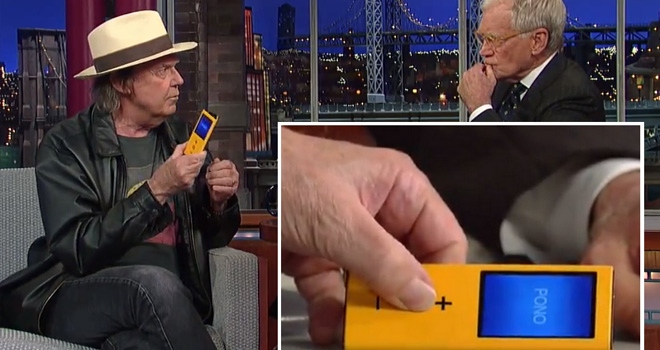
Neil Young to launch music player at SXSW
January 23, 2014, Yahoo.
Neil Young will launch his new music player PONO at the South by Southwest (SXSW) music conference in Austin, Texas in March. Young was awarded the President’s Merit Award from the Producers and Engineers arm of the Recording Academy and said Pono would be launched at SXSW.
Pono is a high quality digital music player that will play the sound as it was recorded in the studio. It will become the hi-tech alternative to low quality MP3 players such as the iPod.
In his speech for the Academy, Young said: “Being impressed by something, and how cool it is, and how sharp it is, and how snappy it is, is one thing, and that translates into almost any media. But when you’re singing something very soulful from your heart, and the echo is perfect and everything’s great and you’re using maybe an acoustic chamber and everything sounds great. And then you listen to it and you love it, but you hear it somewhere else and it’s gone – that’s terrible.
“We don’t like that. Not many of us like that, we’re not happy about it. So we’re trying to change that, and we’re trying to make it better. We’re trying to make music sound technically better, and that’s what I want to do. So we have a player that plays whatever the musicians’ made digitally, and that’s going to come out.
“We’re announcing that at SXSW, we’re introducing it, it’s called Pono, and that’s my commercial, thank you very much.”
:: PONO website
:: PONO technicals: http://xiph.org/~xiphmont/demo/neil-young.html
:: Nyquist sampling theorem: Wikipedia |
New album: “A Letter Home”
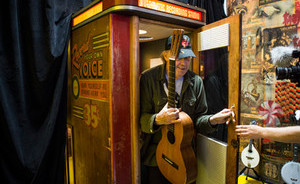
Third Man Records phone booth
Young also set the record straight about rumours of a Jack White duets album. Young states: “False Rumours: Neil Young and Jack White are not doing a record of duets as has been erroneously posted on various outlets. We are certain those rumours have no basis in truth.”
In March, Young will release a new album, A Letter Home, which he describes as “one of the lowest-tech experiences I’ve ever had.” Apparently this is supposed to appear on Jack White’s THIRD MAN record label.
see BNB article:
Tags: A Letter Home, digital audio, Jack White, pono, SXSW, Third Man Records
Posted in News / Article | Comments Off on PONO to be released
Written by bnbrainer on 24 January 2014

Op-ed on anti-Neil arguments, using straw man, shoot-the-messenger, ad-hominem common logical fallacies (A List Of Fallacious Arguments here).
On Wed, 2014-01-22 DAVID VEITCH writes:
Debunked: The Top 10 Stupid Arguments in Neil Young Debate
The Honour the Treaties tour is now over and, as Neil Young presumably heads back to his California home, mission accomplished, the Canadian media — especially the Alberta media — can find another reason to hyperventilate.
It was a tough time for me, a former journalist, reading many opinion columns inspired by Young’s tour and his recent statements about the Alberta oilsands.
Not because I’m pro-oilsands.
Not because I’m anti-oilsands.
Nope, I found the op-ed pages infuriating to read because, above all else, I am anti-stupid arguments. And from what I read in Alberta newspapers, columnists made a ton of them in the days leading up to Young’s final show in Calgary.
Valid criticisms of Young’s position were difficult to find in the media — not because the musician’s provocative opinions were beyond reproach but because many op-ed writers seemingly lost touch with their critical faculties. They resorted to name-calling (“Hypocrite! Hippie! Old dude!”) and backed up their opinions with the same collection of asinine arguments.
In an exercise of possible self-loathing, I started making a list of the media’s most common stupid arguments why Canadians shouldn’t listen to what Young has to say. Read on, if you dare, but be warned these could make your brain hurt:
- “He’s an aging rocker.” Yes, you heard correctly. Media has uncovered the disturbing fact that the 68-year-old ages one year every Nov. 12 which, apparently, makes his opinions entirely invalid. If you want the truth about oilsands development, seek out Benjamin Button.
- “He’s a celebrity.” Columnists argue being famous for one thing precludes you from having knowledge about something else. Except there are approximately a gazillion examples that refute this argument. Off the top of my head: comedian Jay Leno and cars; filmmaker Woody Allen and jazz; Prime Minister Stephen Harper and hockey; singer Miley Cyrus and, um, wrecking balls.
- “He’s a pot-smoking hippie.” So was Steve Jobs and he wasn’t exactly a know-nothing deadbeat. Next…
- “He lives in the U.S., so he should get his nose out of Canada’s business.” This argument is particularly irritating when it comes from columnists who regularly chime in about U.S. policy on, say, the Obama administration’s handling of the Keystone XL Pipeline Project.
- “He was born in Canada but lives in the U.S. He’s not Canadian anymore.” Just to be clear: with this argument, columnists are referring to Young, not Canadian-born companies such as Nexen and Husky Energy, which are now controlled by foreign interests.
- “He’s using this anti-oil crusade to sell his electric car.” Oh how I laugh when columnists trot out this supposed smoking gun, as if to suggest Young has more to profit from spinning the truth about oilsands development than oil companies.
- “But he flies in planes, which use oil, and he sold records, which are made of oil. So he’s a hypocrite.” Of course, almost everyone on Earth uses a product derived from petroleum; this argument suggests no one has the moral authority to question the actions of Big Oil. Using the same argument, newspaper columnists should never criticize or question municipal, provincial and/or federal governments because they surely use these government services.
- “He compared what’s happening in Fort Mac to the human tragedy of Hiroshima — that’s an insult to the families of those who perished in the atomic bomb blast.”No, Young did not say that. (For the record, he said the region “looks like Hiroshima.”) Nor did he say he wants all oilsands workers to lose their jobs. Nor did he tell children Santa isn’t real. This straw man was No. 1 on the Logical Fallacy Charts during Honor the Treaties Week.
- “He should shut up and sing.” So say the columnists who’ve never bothered to listen to the lyrics of After The Goldrush (“We got Mother Nature on the run”) or Vampire Blues (“I’m a vampire, babe, suckin’ blood from the earth/Well, I’m a vampire, babe, sell you 20 barrels worth.”)
And finally…
- “He’s irrelevant.” Hundreds of column inches dedicated to Young’s every word suggest otherwise.
http://www.desmog.ca/2014/01/22/debunked-top-10-stupid-arguments-neil-young-debate
Tags: logical fallacy
Posted in Neil-unsorted-MISC-trivia, News / Article | 2 Comments »
Written by bnbrainer on 22 January 2014
Update:
Third Man Records unearths NEIL YOUNG’s A LETTER HOME
An unheard collection of rediscovered songs from the past recorded on ancient electro-mechanical technology captures and unleashes the essence of something that could have been gone forever. — Homer Grosvenor
http://thirdmanrecords.com/news
Neil Young’s Low-Tech New Album ‘A Letter Home’ Due in March.
“It’s one of the lowest-tech experiences I’ve ever had,” he tells Rolling Stone.
Your next record’s coming out in March?
Yeah, it’s one of the lowest-tech experiences I’ve ever had.
How come?
You’ll hear it. It’s called A Letter Home.
Read more: http://www.rollingstone.com/music/news/neil-youngs-low-tech-new-album-a-letter-home-due-in-march-20140122
Update (2):

Third Man Records phone booth
It seems likely that Young recorded the album on a 1947 Voice-o-Graph machine located at Third Man’s Nashville headquarters.
“There’s something that happens with one mic,” Young said Tuesday night as he accepted the President’s Merit Award from the Producers & Engineers Wing. “When everyone sings into one mic, when everybody plays into the same mic: I’ve just never been able to do that, with some rare instances like when I record in a recording booth from a 1940s state fair. I got that sound by closing myself into a telephone booth. And I notice, it sounds just like an old record. And I like the sound of old records! I’ve always loved that.”
Originally made in 1947, the Voice-o-Graph is the only public vinyl record recording booth of its kind left in the world. After refurbishing it, Third Man opened the booth on Record Store Day 2013 and now anyone can come in and record up to two minutes of audio that’s cut onto a six-inch phonograph disc. Young stopped by Third Man last year where he recorded a cover of Bert Jansch’s “The Needle of Death” on the Voice-o-Graph last year for a special tribute to the acoustic guitar master.
Read more: rollingstone.com/music/news/third-man-records-releasing-neil-youngs-a-letter-home-20140123
Tags: A Letter Home, new album, phone booth, Voice-o-Graph
Posted in Album Info, News / Article | 1 Comment »
Written by bnbrainer on 22 January 2014
Some photos from the the 56th GRAMMY Awards P&E Wing Event Honoring Neil Young at The Village Recording Studios in Los Angeles [click to enter picture gallery]:
And here is Neil’s epic speech to the audience (from Rolling Stone) :
“So this is a cool night because we’re all here together. I know almost everybody here. If I don’t know you, I thought I did when I saw you. It really is great. A lot of us, you know, producers and engineers –I’m kind of a producer, partially, an engineer, I’m not really good at either one. It’s hurt my records in the past. We’re performance-oriented: technical things don’t matter that much.
That’s only one way of making records. A lot of you out here are craftsmen: just beautiful records, and take great care with every note. And I know I’m not one of them. I like to capture the moment. I like to record the moment. I like to get the first time that I sung the song. I like to get the first time the band plays the song. So there’s a lot of compromises you make to get that feeling, but in the long run, that’s where the pictures are when I hear my words and when I see the pictures while I’m listening. So that’s what we try to record.
Recording is so important. We think about the equipment, we think about what are we using, what do we have, what are we recording on, what are we singing through, where is it going, how long is the wire? Why is that piece of shit in the wire between me and where I’m going? Get that out! Don’t join the wire together, get one wire, because every time you go through one of those pieces of crap, something happens. We paid big bucks for this place, and we’re going to use every bit of it. And we’re not going to use what we don’t want. Thank you. Great recording here.
I did record here! I think I recorded a few tracks here a long time ago. There’s a song, “Like a Hurricane,” that I didn’t record here. But I couldn’t sing at that time, when I recorded that, because I had just had some sort of operation. They told me to stop for a month, but I couldn’t stop the music, so in my studio at home, me and Crazy Horse got together and we played this track. It was about fifteen minutes long, because I’d just written it the night before. I recorded it on an acoustic – now let’s play with all these other instruments and it’s going to be great.
So we got the instruments out and we played it once. And we screwed it up really badly at first. If you listen to the record, you can tell we screwed it up. We cut it off. It just starts out of nowhere. But that was over – now we’re in the record. And it’s divided, it doesn’t matter how cool and together the beginning was, but where it went as soon as it started. So we shortened a little bit.
Then I was here at this place, in 1974 or something, and I said, “You know, a couple of weeks ago, when I couldn’t sing – ” By the way, I know I can’t sing. I mean I couldn’t make a sound. And of course, this was back in the day, way back there. So I’m saying, “We have this tape here. I brought this piece to multitrack. We’ve never played it. I’m going to sing it, because I never got a chance to sing it.”
So we put it on, and he played back about ten seconds, and I said, “Okay, stop. Everything was working, right? We heard everything? Okay, there’s no reason to listen to it. Because I was there – I know what it is. And it’s on the tape. We don’t have to listen to it. Let’s not wipe the shit off the tape listening to it. Let’s record while the stuff is still on – let’s listen to what’s there, and record it to a two-track while it’s still there.” Because if you listen over and over and over again, it goes away, bye-bye! Because the tape doesn’t like to rub over this head, and then part of it goes away, it’s terrible. That bothers me every time the tape plays. So I never hardly ever listen!
Okay, they put the tape on and I went out and I talk: “Am I there?” Yes. “Good. Okay. Record. Number one. Just record all the time – that’s why we’re here. Don’t not record at all, ever. Record! It’s a studio! Record! Practice at home! The red button’s not that scary, really not.”
So we press the button and they start the tape, and I start singing the song. It’s long, so it’s like, four or five verses over and over again. So I sing one verse, and then the other verse – there’s only two verses, so I just keep singing them, one after the other. Later on, we can cut it down. The other guys aren’t here, and I hear the harmony part, so I want to sing the harmonies now. We did the harmonies, so we did three tracks, three times through, one time on each track. We had all this stuff, and it was the first time I ever heard it. The first time I ever listened to “Like a Hurricane.” And I was hearing it, and I was singing it, and I sang the harmony, and I sang the other harmony, and then we mixed it. So it was like the five-and-sixth time, and then we mixed it. There’s a message in there somewhere.
My memory of this place is what it is, that we do records like that. The idea is, for me, to try to get magic. Who knows where the hell it’s coming from? I don’t – so please record. It’s expensive to sit here and not push the button.
I know who you people are. I know you’re animals, and I know some of you are very funny. Some of you are just dry – never laugh. “Good morning.” I love you all people, because I know what you’re doing. I know how crazy you are about all the things that I don’t care about. Sometimes you make great records, and it’s fantastic. They’re not like my records – sometimes I can’t feel them, but I really appreciate them. No, sometimes I can feel them and I go, “Holy shit, how did they do that? How did they make that record? I know they layered it – it’s not like a documentary where something happens and you take a picture, cinema verite. This is a movie: somebody created all the scenes, and there was the dialogue, and then they did the dialogue again, and there was the foley to do the sounds, and they did all the stuff, and everything’s perfect – but it’s still good.”
There’s nothing wrong with that – it’s just a different way of doing it than I could ever do, because I have so little ability to do that, that it would really suck: over and over again, getting it right. That’s why I’m flat, that’s why it doesn’t matter that there’s bad notes. That doesn’t mean it’s not production – it just means it’s the kind of production that we do.
Some people are here tonight that I’ve worked with over the ages that are just really incredible people. Al Schmitt’s here tonight. And Niko Bolas, he’s here. John Hanlon is here. I really appreciate that these guys are – I know you really appreciate, especially Al, because he’s the father of what’s going on here, and he’s still here. He has staying power. And he was recording the way that I want to record now. I’m going to make a record with Al – we’re talking about making a record together where there’s only one mic, but we do a huge orchestra. And when we finish doing that performance, and every guy’s standing the right length from the mic: the background vocal is like “hey-hey-hey,” and of course I’m up here, but they’re right there, so it sounds like that there. So we’re going to do it that way. We’re not going to mix it: we’re going to do it, and mix it while we do it. Everybody can get in the right place, and if it’s not righ – -well, we’ll
move the bass up. Move the bass closer. It’s not loud enough? Move the amp closer, then! It sounds good, but it’s just too quiet, so move it up. Move it in, and the drums? Leave it over there, go back farther.
Do you know how fun that is to do? That is so much fun. It’s like playing music – it’s not making music, it’s playing it. I love doing these things. And I’m anxious to do something I’ve never done before, because there were great records made that way. There’s something that happens with one mic. When everyone sings into one mic, when everybody plays into the same mic: I’ve just never been able to do that, with some rare instances like when I record in a recording booth from a 1940s state fair. I got that sound by closing myself into a telephone booth. And I notice, it sounds just like an old record. And I like the sound of old records! I’ve always loved that.
So all I’m trying to say is I’m one of you. You honor me, you’re honoring yourself. It’s not me: it’s you. It’s what we do. Thank you so much. Digital. Digital is not bad. But Xerox is not good. I always like to say Picasso was really happy to see original Picassos everywhere, but when he went into some places and saw Xeroxes of Picassos, it didn’t make him as happy, because he thought people thought that we was making those things. The thing we do is, we make great stuff in the studio and then we kiss its ass goodbye, because nobody’s ever going to hear it. That’s unfortunate, and it didn’t use to be that way. That’s something that happened to us – that’s an injury we sustained, and it deeply hurt us. So the time has come for us to recover and to bring music back to the people in a way that they can recognize it in their souls – through the window of their souls, their ears. So they can feel and vibrate and so that they can get goosebumps. We
cherish those fucking goosebumps. We really need those.
Being impressed by something, and how cool it is, and how sharp it is, and how snappy it is, is one thing, and that translates into almost any media. But when you’re singing something very soulful from your heart, and the echo is perfect and everything’s great and you’re using maybe an acoustic chamber and everything sounds great. And then you listen to it and you love it, but you hear it somewhere else and it’s gone – that’s terrible. We don’t like that. Not many of us like that, we’re not happy about it. So we’re trying to change that, and we’re trying to make it better. We’re trying to make music sound technically better, and that’s what I want to do. So we have a player that plays whatever the musicians made digitally, and that’s going to come out. We’re announcing that at SXSW, we’re introducing it, it’s called Pono, and that’s my commercial, thank you very much.
Read more: http://www.rollingstone.com/music/news/read-neil-youngs-full-epic-speech-from-grammy-honors-ceremony-20140122
Tags: GRAMMY, pono
Posted in Awards, News / Article | Comments Off on Grammy awards photos and Neil’s full epic speech
 An insightful blog posting by Angelina Pratt – a beneficiary of Neil Young’s 2014 Canadian tour and member of the First Nation Athabasca Chipewyan.
An insightful blog posting by Angelina Pratt – a beneficiary of Neil Young’s 2014 Canadian tour and member of the First Nation Athabasca Chipewyan.





